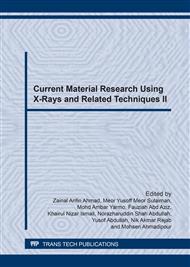[1]
T. Gallaher, M.W. Callmander, S. Buerki, S. C. Keeley, A long distance dispersal hypothesis for the Pandanaceae and the origins of the Pandanus tectorius complex, Molecular Phylogenetics and Evolution, 83 (2015) 20-32.
DOI: 10.1016/j.ympev.2014.11.002
Google Scholar
[2]
Nadaf, R. Zanan. World Pandanaceae: An overview Indian Pandanaceae: An overview, 2012, pp.1-9, Springer.
DOI: 10.1007/978-81-322-0753-5_1
Google Scholar
[3]
H. Takayama, T. Ichikawa, M. Kitajima, N. Aimi, D. Lopez, M. G. Nonato, A new alkaloid, pandanamine; finding of an anticipated biogenetic intermediate in Pandanus amaryllifolius Roxb., Tetrahedron Letters, 42(16) (2001) 2995-2996.
DOI: 10.1016/s0040-4039(01)00339-2
Google Scholar
[4]
L.S.M. Ooi, E.Y.L. Wong, S.S.M. Sun, V.E.C. Ooi, Purification and characterization of non-specific lipid transfer proteins from the leaves of Pandanus amaryllifolius (Pandanaceae), Peptides, 27(4) (2006), 626-632.
DOI: 10.1016/j.peptides.2005.08.019
Google Scholar
[5]
A. Ningrum, M. Schreiner, Pandan leaves: Vanilla of the East, as potential natural food ingredient, Agro Food Industry Hi Tech, 25(3) (2014) 10-14.
Google Scholar
[6]
J. Rajeswari, K. Kesavan, B. Jayakar, Phytochemical and pharmacological evaluation of prop roots of Pandanus fascicularis Lam, Asian Pacific Journal of Tropical Medicine, 4(8) (2011) 649-653.
DOI: 10.1016/s1995-7645(11)60165-x
Google Scholar
[7]
H. Chong, S. Yeap, A. Rahmat, A. Akim, N. Alitheen, F. Othman, C. Gwendoline-Ee, In vitro evaluation of Pandanus amaryllifolius ethanol extract for induction of cell death on non-hormone dependent human breast adenocarcinoma MDA-MB-231 cell via apoptosis, BMC Complementary and Alternative Medicine, 12(1) (2012).
DOI: 10.1186/1472-6882-12-134
Google Scholar
[8]
T.K. Lim. Edible medicinal and non-medicinal plants, Volume 4: Fruits, Springer (2012).
Google Scholar
[9]
R.M. Sheltami, I. Abdullah, I. Ahmad, A. Dufresne, H. Kargarzadeh, Extraction of cellulose nanocrystals from mengkuang leaves (Pandanus tectorius), Carbohyd. Polym. 88 (2) (2012) 772-779.
DOI: 10.1016/j.carbpol.2012.01.062
Google Scholar
[10]
Y.B. Cheng, Y.H. Tsai, I.W. Lo, C.C. Haung, Y.C. Tsai, L. Beerhues, M. El-Shazly, M.F. Hou, S.S. Yuan, C.C. Wu, F.R. Chang, Y.C. Wu, Pandalisines A and B, novel indolizidine alkaloids from the leaves of Pandanus utilis, Bioorg. Med. Chem. Lett. 25(19) (2015).
DOI: 10.1016/j.bmcl.2015.07.041
Google Scholar
[11]
X. Zhang, H. Wu, C. Wu, P. Guo, X. Xu, M. Yang, Pandanusphenol A and B: Two new phenolic compounds from the fruits of Pandanus tectorius Soland, Records of Natural Products, 7(4) (2013) 359-362.
Google Scholar
[12]
P.P. Adkar, V.H. Bhaskar, Pandanus odoratissimus (Kewda): A review on ethnopharmacology, phytochemistry and nutritional aspects, Advances in Pharmacological Sciences, 12 (2014) 1 – 19.
DOI: 10.1155/2014/120895
Google Scholar
[13]
K. Southwell, R. Harris, Chemical characteristics of pandanus conoideus fruit lipid, J. Sci. Food Agr. 58 (4) (2006) 593 – 594.
DOI: 10.1002/jsfa.2740580422
Google Scholar
[14]
Z.L. Sarungallo, P. Hariyadi, N. Andarwulan, E. H. Purnomo, M. Wada, Analysis of α-Cryptoxanthin, β-Cryptoxanthin, α -Carotene, and β-Carotene of Pandanus Conoideus Oil by High-performance Liquid Chromatography (HPLC), Procedia Food Science, 3 (2015).
DOI: 10.1016/j.profoo.2015.01.026
Google Scholar
[15]
A. Rohman, R. Sugeng, Y.B. Che Man, Characterization of red fruit (Pandanus conoideus Lam) oil, International Food Research Journal, 19(2) (2012) 563-567.
Google Scholar
[16]
Ng, Francis S. P. Tropical Horticulture and Gardening. 1st Edition. MPH Publishing, Malaysia, (2010).
Google Scholar
[17]
T.W. Shiao, M.S. Shiao, Determination of fatty acid compositions of triacylglycerols by high resolution NMR spectroscopy, Bot. Bull. Academia Sinica, 30 (1989) 191-199.
Google Scholar
[18]
H.Z. Chong, R. Asmah, M.A. Abdah, M.A.N. Banu, O. Fauziah, G.E.C. Liang, Chemical analysis of pandan leaves (Pandanus amaryllifolius), International Journal of Natural Product and Pharmaceutical Sciences, 1(1) (2010) 7-10.
Google Scholar
[19]
L. Wu, J. Tan, H. Chen, C. Xie, Q. Pu, Chemical constituents of thatch screwpine (Pandanus tectorius), Zhongcaoyao, 18 (1987) 391-393.
Google Scholar


